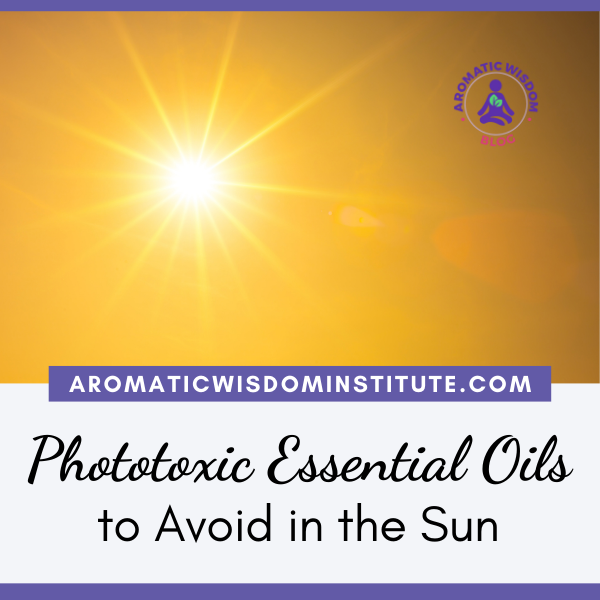🎧Prefer to Listen? Click below
or here: AromaticWisdomPodcast.com/36
Phototoxicity and Essential Oils: An Overview
Phototoxicity is a crucial consideration when using essential oils, especially during sunny months and in regions with high UV exposure. Many essential oils contain compounds that can cause the skin to become more susceptible to damage when exposed to ultraviolet light. Understanding phototoxicity is essential for the safe and effective use of essential oils in aromatherapy and personal care routines.
Understanding Phototoxic Reactions: Signs and Symptoms
Phototoxic reactions from essential oils may occur 12 to 24 hours after exposure. Symptoms can range from mild redness and sunburn to more severe blisters and skin discoloration. It is important to recognize that the severity of the reaction can be influenced by various factors, including the specific essential oil, its concentration in a product, and the duration of sun exposure.
Types of Phototoxic Essential Oils: Cold-Pressed vs. Steam-Distilled
Cold-pressed essential oils, particularly citrus oils, contain 4ocumerins, which are responsible for causing phototoxic reactions. Common examples of phototoxic essential oils include Bergamot, bitter orange, grapefruit, lemon, and lime. On the other hand, steam-distilled essential oils are safer as they do not contain heavy 4ocumerins. Some non-phototoxic alternatives to cold-pressed citrus oils include Bergamot FCF, blood orange, steam-distilled lemon, and sweet orange.
Further Resources: Essential Oil Safety
For those seeking in-depth knowledge on phototoxic essential oils, “Essential Oil Safety” by Robert Tisserand and Rodney Young is a highly recommended resource. This comprehensive guide offers detailed information on the safe use and potential risks associated with essential oils, including phototoxicity.
Personal Experience: Using Lemon Essential Oil Safely
A personal experience shared by a clinical aromatherapist highlights the importance of understanding the limited shelf life of citrus essential oils. The speaker recounts using lemon essential oil to clean a refrigerator, emphasizing the need to protect the skin from potential phototoxic reactions. This experience underscores the importance of using caution and understanding the properties of essential oils, especially when using them in household applications.
Safe Application of Phototoxic Essential Oils
When using phototoxic essential oils in topical applications, particularly during sunny weather, it is essential to exercise caution. Diluting the essential oils and minimizing sun exposure after application can help reduce the risk of phototoxic reactions. Additionally, using non-phototoxic alternatives or steam-distilled versions of citrus oils can provide safer options for topical use in skincare and personal care products.
Cleaning with Phototoxic Essential Oils: A Cautionary Tale
The application of lemon essential oil in cleaning routines provides an excellent example of the potential risks associated with phototoxic essential oils. The speaker’s cautious approach to using a mixture of warm water, liquid castile soap, and lemon essential oil for cleaning the refrigerator emphasizes the need to protect the skin from potential phototoxic reactions. The detailed cleaning process, including using baking soda for tough spots and lining shelves with saran wrap, highlights the meticulous care required when using phototoxic essential oils in household applications.
Looking Ahead: Safety and Sensitization in Essential Oil Use
The episode concludes by inviting listeners to join the next discussion on safety and sensitization in essential oil use, emphasizing the natural and health benefits of essential oils and the importance of using them safely. Listeners are encouraged to share their questions and topics for future episodes, fostering engagement and creating a sense of community around informed essential oil use.
Closing Thoughts: Embracing Safe and Informed Essential Oil Use
Understanding the dangers and potential benefits of using phototoxic essential oils is essential for incorporating them into daily routines safely. By recognizing the signs and symptoms of phototoxic reactions, choosing appropriate alternatives, and following safe application practices, individuals can harness the natural properties of essential oils while protecting their skin from potential harm. As the episode imparts valuable knowledge about phototoxic essential oils, it encourages listeners to embrace safe and informed essential oil use, fostering a mindful and responsible approach to aromatherapy and personal care practices.
This comprehensive guide provides an insightful overview of phototoxic essential oils, offering valuable information and practical advice for readers seeking to understand, use, and enjoy the benefits of essential oils safely.




